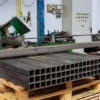In the evolving landscape of industrial manufacturing, robotic machining stands out as a critical technology driving significant changes. This process involves using robots to automatically load and unload production machines, a task traditionally performed by human operators. Integrating robotics into these roles enhances efficiency and reshapes the manufacturing floor with heightened precision and reliability.
Robotic Machine Tending streamlines complex workflows, reduces cycle times and minimizes human error. Automating these tasks facilitates a more agile production environment, adapting quickly to product design and market demand changes, henceforth fostering a more dynamic manufacturing process.
What Is Robotic Machine Tending?
It refers to using robotic systems to handle materials, parts, and tools for other machines during manufacturing. Typically, this includes loading raw materials into a machine and unloading finished parts. It is most commonly seen in the automotive, metal fabrication, and plastics industries, where high-volume production and precision are critical. This technology is instrumental in optimizing the efficiency of production lines, reducing labor costs, and improving safety standards. It also allows for more consistent cycle times and better quality control, making it an invaluable asset in modern manufacturing environments.
Increased Production Efficiency
One of this technology’s primary advantages is its significant increase in production efficiency. Robots can operate continuously without fatigue, reducing downtime and significantly boosting output. They can work at consistent speeds and be programmed to operate 24/7, allowing for a dramatic increase in production capabilities compared to human-operated setups.
Enhanced Precision and Quality Control
Robots are not only faster but also more precise than humans in repetitive tasks. This precision results in higher-quality products with fewer errors, which is crucial in industries where consistency and adherence to specifications are paramount. The accuracy of robotic tending systems helps maintain uniformity in the production line, thus enhancing overall product quality.
Safety and Ergonomics
Implementing robotic systems for machine tending improves workplace safety and ergonomics. These robots take over physically demanding and potentially hazardous jobs, reducing the risk of injuries and accidents on the factory floor. This shift protects workers and reduces the likelihood of costly disruptions due to workplace accidents.
Integration with Advanced Technologies
Connectivity and Automation
The rise of the Internet of Things (IoT) and intelligent factory initiatives has made this technology even more valuable. These robots can be integrated into a broader network of connected devices, allowing for seamless communication and automation across various stages of production. This connectivity enables real-time data collection and analysis, leading to optimized operations and predictive maintenance schedules.
Artificial Intelligence and Machine Learning
Advancements in artificial intelligence (AI) and machine learning are enhancing the capabilities of these systems. AI algorithms can enable robots to adapt to changes in the production environment or to handle unexpected variables. Over time, these systems can learn and improve operations, leading to even greater efficiencies and reduced human intervention.
Impact on the Workforce
Job Transformation
While it does automate tasks traditionally performed by humans, it also transforms job roles rather than merely replacing them. Workers are increasingly required to oversee and maintain robotic systems, shifting the focus from manual labor to more technical and supervisory roles. This change demands a higher skill level and training, promoting a more knowledgeable and adaptable workforce.
Skills Development and Training
The shift toward robotic automation necessitates enhanced training programs and continuous professional development for employees. Training focuses not only on operating and maintaining these robotic systems but also on interpreting data and managing integrated systems. This evolution in training enhances worker competencies and prepares the workforce for future technological advances.
Future Prospects
Sustainable Manufacturing
It contributes to more sustainable manufacturing practices by improving resource efficiency and reducing waste. Robots ensure precise material handling and processing, which minimizes material wastage. Additionally, the energy efficiency of robotic systems can be optimized more effectively than manual processes, supporting greener manufacturing initiatives.
Expanding Applications
As technology progresses, the applications of them are expanding beyond traditional domains. Industries such as pharmaceuticals, electronics, and even food processing are beginning to adopt these technologies to enhance precision, efficiency, and safety. The versatility and adaptability of robotic systems suggest that their impact will continue to grow, influencing a broader range of industries.
Integrating Robotic Machine Tending in manufacturing marks a pivotal shift in how products are made. By enhancing efficiency, precision, and safety, these robotic systems are transforming production floors and setting new standards for the manufacturing industry. As technology continues to evolve, its role will undoubtedly expand, playing a critical role in shaping the future of manufacturing, driving innovation, and fostering a safer, more efficient, and sustainable industrial environment.










